
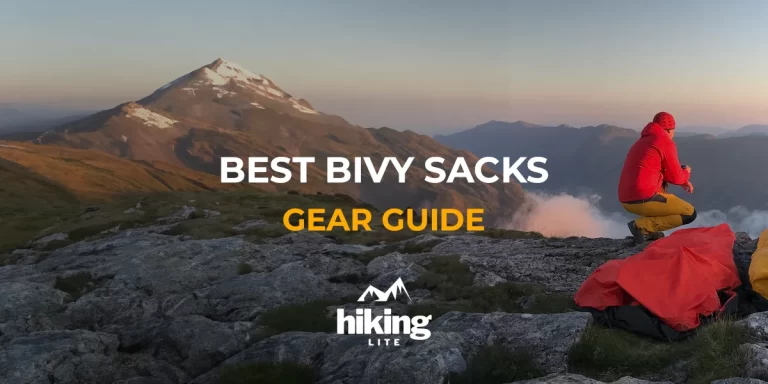
When planning a backpacking trip, selecting the right shelter is one of the most important gear decisions. Your shelter needs to protect you from the elements while also packing down small and light to minimize pack weight.
Bivy sacks are a top option for ultralight backpackers looking to travel fast and light. However, with the many bivy sack models on the market, it can be hard to identify the best bivy sacks for your needs.
In this guide, we’ll showcase our top five picks for the best bivy sacks available.
Let’s get started.

Key Specs
Weight: 11.9 ounces (340g)
Material: 20D nylon ripstop
Price: $$
PROS
✅ Ultralight
✅ Spacious
CONS
❌ No zipper
❌ Thin fabric
The Pro Bivy is a no-frills, lightweight shelter tailored for experienced ultralight backpackers. At just 12 ounces, it compresses small to not weigh down fast and light adventures.
Constructed of weatherproof yet breathable fabric, the Pro Bivy protects from wind and rainfly while reducing inner condensation. Its durable Xtreme Shield coating effectively repels water for reliable protection during alpine trips.
Though simple in design with no zipper closure, the Pro Bivy is versatile – fitting into tight spots unsuited for bulkier tents. This makes it a handy tool for minimalist backpackers seeking only basic overhead shelter.
While the thin fabric risks moisture intrusion without supplementary protection, early testing shows the Pro Bivy performs well in fair conditions. Additional testing is still needed to verify dryness during severe storms.
Overall, the Pro Bivy delivers on its goal of lightweight shelter perfectly suited to technical mountaineering or traversing.
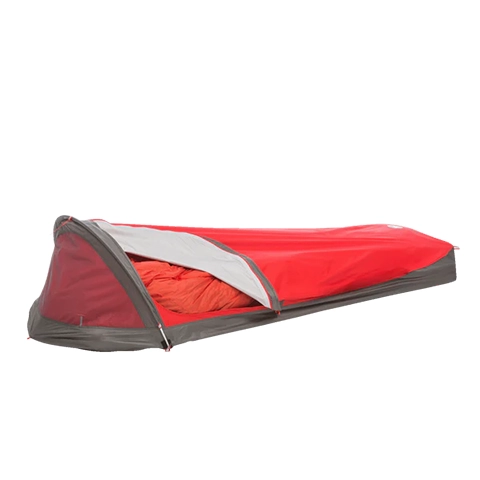
Key Specs
Weight: 18.9 ounces (538 grams)
Material: nylon ripstop
Price: $$$
PROS
✅ Great in bad weather
✅ Small pack size
CONS
❌ Not the best for tall individuals
The Big Agnes Three Wire Hooped Bivy protects from extreme weather without too much weight at just under 20 ounces. It uses quality breathable fabrics and fully taped seams to block water very well.
A mesh window improves airflow and comfort inside. Extra poles create more headroom than other bivies. While it doesn’t add warmth, the bivy does an excellent job limiting condensation buildup.
Testing showed it handles different mountain conditions during all seasons. The space above the head is better than some bivies for taller folks. However, very tall individuals may still feel a bit cramped.
Leaving it open at the top allows flexibility. More testing in cold temps could prove winter performance.
Overall, the Three Wire Hooped Bivy packs strong shelter light. Its construction makes it a smart option. Just be aware that very tall hikers may want a bit more roomy of a shelter.
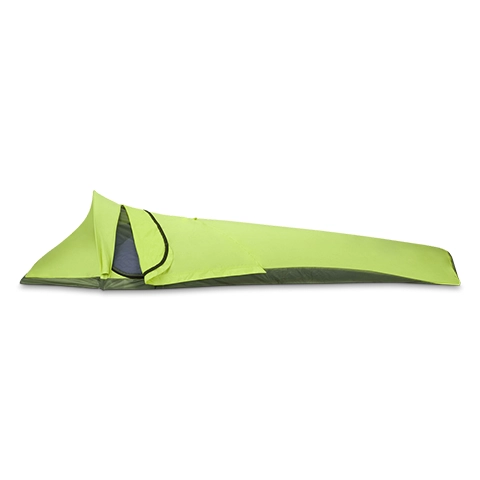
Key Specs
Weight: 23.3 ounces (660 grams)
Material: proprietary fabric (NanoShield)
Price: $$
PROS
✅ Spacious
✅ Great headroom
CONS
❌ Needs additional seam sealing
The Spotlight Bivy strikes an excellent balance between ultralight shelter and added creature comforts. Its single DAC Featherlite pole provides a generous amount of head and shoulder room inside.
Setup is simple and quick with color-coded guylines. Ventilation is superb thanks to the large mesh panel and zippered entry door. Black Diamond’s proprietary NanoShield fabric ensures durable weather protection.
Early testing shows the bivy holds up well to varied mountain conditions. While only the bottom seam is factory sealed, additional seam sealing is straightforward to complete and can further fortify the shelter if needed.
Weight remains low enough for extended backpacking trips. Thoughtful details like the integrated bug net enhance livability.
Though not fully freestanding, the Spotlight Bivy provides a feeling of spaciousness rare in such a minimal shelter.
Overall, this bivy satisfies the desire for the comforts of additional headroom without the bulk of a full-sized tent. Its quality craftsmanship makes it a sensible choice for great value in ultralight shelters.
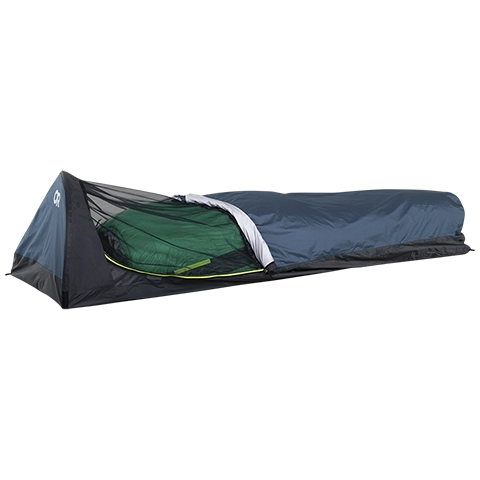
Key Specs
Weight: 18.6 ounces (528g)
Material: proprietary nylon fabric
Price: $$$
PROS
✅ Side zip for easy entry
✅ Excellent in bad weather
CONS
❌ Not for someone over 6 feet
The Alpine AscentShell Bivy offers a comfortable option for lightweight shelter, balancing durability and breathability. Its Pertex and AscentShell construction keeps sleep systems dry despite inevitable moisture.
Key features like the step-in opening, ample headroom and stretched shape promote airflow and comfort for most sleep positions. The integrated bug netting further enhances livability.
Early testing shows the breathable materials effectively resisting interior condensation accumulation. Though seam taping helps, some trim pieces require care to avoid collecting frost.
While its size may not be ideal for taller frames, innovative designing nonetheless achieves a spacious interior without extra bulk. Additional testing is recommended in fringe weather scenarios.
Overall though, those seeking a competent and light bivy will find the AscentShell a durable choice for solo adventures requiring minimal shelter.
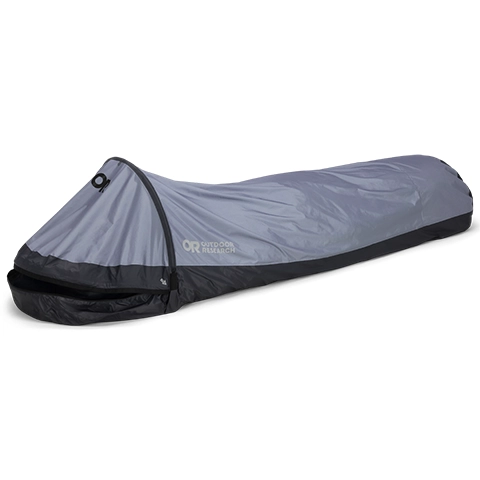
Key Specs
Weight: 15.8 ounces (448 grams)
Material: 30D nylon ripstop
Price: $$
PROS
✅ Small pack size
✅ Relatively affordable
CONS
❌ Entrance opening can sag
❌ Not really waterproof
The Outdoor Research Helium Bivy stands out with its great design. It uses tough Helium fabric and Diamond Fuse technology.
Made for fast, light trips, this bivy opens from the side. Backpackers like using it because it’s reliable gear. It lets you travel far while carrying less weight in your pack.
The front opening may droop some. But a small clip keeps it propped up well.
Hikers and bikers love this bivy. It’s their lightest and best bivy. It packs down tiny and light yet is sturdy. The fabric dries quickly.
Setting it up and packing it away is simple and fast. It has what minimalist outdoor lovers need to feel comfortable. The side opening works for many uses.
It seemed well-made and packed down small and light. However, the rain cover loop had issues on ours. Also, tying back the cover needs improvement. You may want clips to help.
If over 6 feet 3 inches, you will fit inside with extra space.
While great for backpacking due to being light, it’s not fully waterproof. To stay dry in rain, use a separate waterproof tarp suspended above it.
Choosing a bivy over a regular tent for camping involves a trade-off between portability and comfort.
Bivys, originally designed for climbers, are now popular among adventurers seeking a minimalist approach. Before making your decision think of:
Carefully balancing these key elements will allow you to select the lightest, most packable bivy shelter with sufficient weather protection, comfort, and bug defenses for your needs.
When choosing a bivy sack, consider how you will use it such as for long backpacking trips requiring an ultralight weight or occasional car camping with more weight flexibility, evaluate breathable or waterproof materials suited to your conditions along with fully taped seams and waterproof zippers, inspect sizes to match your height and gear space along with tapered designs, think about integrated bug mesh to sleep undisturbed, weigh your must-have features against ultralight or bulkier options after testing samples suited to uses like backpacking versus car camping, and ensure the right balance of features for portable shelter and protection on your adventures.
While bivy sacks prioritize ultralight portability and pack size compared to roomier tents, they remain a viable shelter option for minimalist backpackers seeking to shed unnecessary ounces, as bivys contain all the critical functions of shelter and protection in a streamlined package at the expense of less interior space and full enclosure, as their lightweight flexible fabric, tapered mummy-like designs, and lack of standing room necessitate pairing with supplementary rainflies or tarps for full coverage in inclement weather, but for fair-weather trips or as an emergency shelter in a pack, a bivy offers coverage and bug protection without the bulk and set-up time of a traditional freestanding tent.
While their compact and portable designs make bivy sacks appealing for lightweight hiking, trekking, and survival situations, their durability in rougher outdoor elements deserves consideration, as the thin and flexible fabric solutions must withstand jagged rocks, tree branches, and weather more so than roomier standalone tents, however newer technical materials like Siliconized nylon and waterproof zippers have improved their resilience, and prudent material selection and regular care can enable bivys to withstand typical trail hazards encountered by backpackers as well as short-term 3-season use, meaning with proper precautions during setup, breakdown, and by choosing sufficiently durable fabrics, the low-profile shelters have survived enough brutal expeditions to prove their function for survival and portable shelter needs in backcountry conditions.